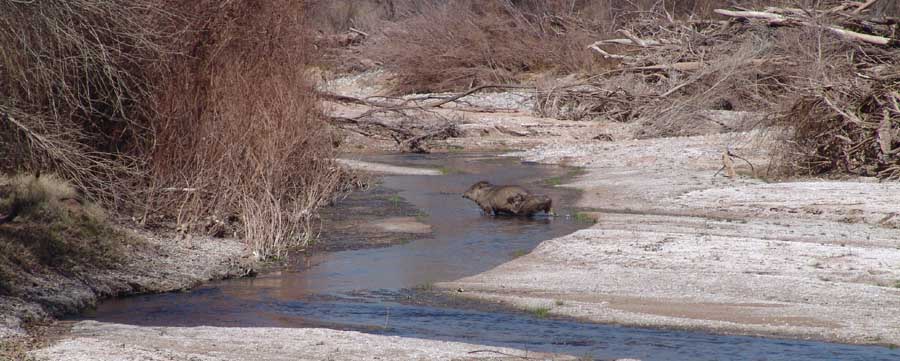
Photo above taken on December 3, 2008 in Lower Hot Springs Canyon. Click on the image to enlarge it.
Javelina or Peccary (Tayassu tajacu)
Main sources: Nowak, Ronald, 1991, Walker's Mammals of the world, Fifth Edition (two vols.), Baltimore: Johns Hopkins University Press; Hoffmeister, D. F., 1986, Mammals of Arizona, Tucson: University of Arizona Press; Burt, W. & R. Grossenheider, eds., 1976, A Field Guide to the Mammals, Peterson Field Guides: Houghton Mifflin;
Javelinas belong to a small family of "Even-toed Ungulates" found from the southwestern US to Argentina. A more primitive genus -- Catagonus -- lives in Argentina along with the much more widespread Tayassu. Javelina are quite distinct from the pigs (Suidae), having for example only 6-9 tail vertebrae (pigs have 20-23). While the body form is piglike, the legs are long and slim and the hooves are small. See the tracks further below. The snout is very piglike: elongated, considerably mobile, cartilaginous, with a nearly naked terminal surface. The hair coat is bristly, with "a mane of long, stiff hairs on the middorsal line from the crown to the rump" (Walker II:1344) In the banner image above, the animal on the right is probably male, the one on the left female (males are somewhat larger and have darker manes). Javelinas have a scent gland on the rump in front of the tail, which emits a strong-smelling odor when the animal is excited. The stomach is complex, but non-ruminating. Tayassuidae are found in the early Oligocene in Europe, middle Miocene in North America. A late Pleistocene genus, Platygonus, found throughout the coterminous United States about 12,000 years ago, was much larger than the living genera. (Walker II: 1344-5)


Below, several examples of Javelina tracks. At left, in drying mud; center, tracks left in damp sand in Upper Cottonwood Seep Wash in January 2005; at right, front paw tracks left in wet mud in the Diversion Tank, October 2006. (Click on the center and right images to enlarge them.)
 .
. .
.
Members of our Tayassu genus reach 50 pounds in weight, stand as much as two feet high, and have two-toed front feet, three-toed behind (the 3rd, vestigial dewclaw does not however show in tracks unless the track is made in mud). The Diversion Tank tracks at above right include one that shows the stamp of the dew claw (just left of the pen's top). In the Javelina these stamp close by the main hoof, whereas in deer the stamp marks occur separated at a distance from the main track (see deer).
In January 2007 we encountered this remnant Javelina hoof below on a terrace in Lower Hot Springs Canyon. It was clearly a remnant of a predator's feast (probably Mountain Lion), but had been transported to the terrace, probably by a packrat since a packrat's nest was close by. (Click on each image to enlarge it.) In all three images, note the size of the dewclaws and their close proximity to the hoofs proper. The exposed proximal bones are pieces of the carpal bones of the animal's ankle. The center image shows that this was an elderly animal, its hoofs much worn into a curve at the upper ends.
 .
. .
.
Compare these tracks and hoofs with those of the fairly similar-shaped even-toed hooves of our deer.

Javelina are highly gregarious, and live in fairly stable herds running from about 10 to 20 individuals, which range over flexible-sized territories determined mainly by water and food, with boundaries marked by their scent glands. Our peccaries prefer desertscrub thickets along washes, especially where cacti (a principal food) are present, and they prefer prickly pear while eating a variety of other vegetable foods, as well as insect grubs and eggs (they qualify as omnivores). In the image below, four members of a herd of about 10 feed on new-blooming wildflowers in March of 2001. This particular wash appears to be a central feature of this particular herd's home range.

Below, a mother and her offspring cross the San Pedro River on Three-Links Ranch land in March 2007. The pair were following the dominant male, who had crossed the river a few moments before after surveying the situation for security, and several other adults followed behind. Click on the image for a close-up of the pair. The young one has gotten itself thoroughly wet.

Javelina have poor vision, fair hearing, and a keen sense of smell. They are quite clean animals, pawing sand against their bellies in a cleaning motion. They are most active in early mornings and late evenings. Our species breeds mainly in the spring, giving birth during the summer to 1-4 young, who can run in a few hours after birth and can follow their mothers within a day or so. They are known to live as long as about 25 years.
Below, a view of the base of a Javelina skull. (The foramen magnum --the hole that accommodates the spinal cord -- is toward the right.) You can see the array of sockets for the grinding teeth typical of ungulates, and also the two forward- and laterally-protruding sockets for the (missing) canine teeth, which in life are large, sharp tusks, which they often clash together in warning -- the name "javelina" refers to their possession of these "spears". Click on the image for a tooth-socket closeup. Note that part of the "snout" portion of the skull is missing from this specimen.

Below, a strongly bleached skull seen from the side. The eye socket is central-right, and in this case the tusks still persist on the skull. (Click on the image for a close-up of the tusk.)

Below, the same skull seem from further below. A few of the grinding teeth, and one of the incisors, remain, and the two tusks show clearly here. The enamel is breaking up on both, but the sharpness of these teeth can still be seen. (Click on the image for a close-up of the tusks.)

Peccaries usually run from humans, but if a member of the herd is accosted, the entire herd may counterattack, and they are capable of delivering serious bites. Their "speed, agility, and group defense... render them more than a match for dogs, coyotes, and even bobcats." (Walker II:1346)
These animals are quite intelligent -- captive ones may recognize human friends, know their own names, and come when called.

Return to Mammals